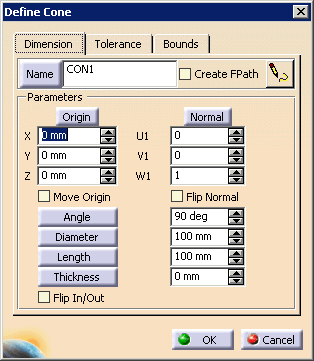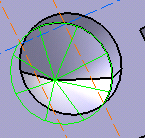 |
-
Select the parent process or preceding activity for
the define cone activity.
-
On the Inspection Activities toolbar, click
Define Cone
 . .
| The Define Cone dialog box appears. |
 |
 |
When you first create a feature, you need to select a
thickness for it. Inspect uses that thickness value as the
default value thereafter. |
| |
You may enter a name for the cone in the name frame. |
 |
See also Using Bounds. |
-
On the 3D geometry, select the cone or provide values
within the spin boxes.
| Once selected, the cone is highlighted and a green
arrow, signifying normal, protrudes from it. You can flip
normal by selecting the Flip Normal box. |
 |
 |
For an image defining the dimensions, click on the button. The image appears.
The image appears. |
| |
 |
| |
You can also alter the direction of Origin, Normal,
Diameter, Angle, Length, and Thickness by
selecting the buttons with those parameter names. |
| |
If you select any of these buttons, the dialog box disappears,
and the appropriate toolbox appears in its place. Select the
button on the toolbar that changes the direction as desired. |
| |


 |
 |
See About the Toolboxes for
information on using the toolboxes. |
-
Select the OK button.
| The activity is added to the PPR tree and the cone is
highlighted on the geometry. |
 |
|






